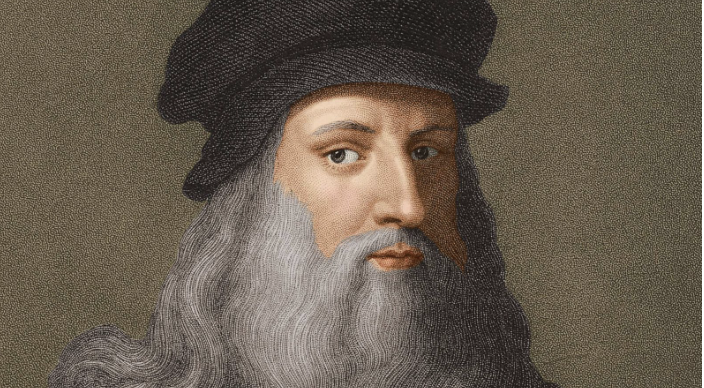Chances Are Leonardo da Vinci Was Jewish
By Marc Weitzmann (originally published in the Tablet, reprinted with permission of Aish.com)
In all likelihood, Leonardo da Vinci was only half Italian. His mother, Caterina, was a Circassian Jew born somewhere in the Caucasus, abducted as a teenager, and sold as a sex slave several times in Russia, Constantinople, and Venice before finally being freed in Florence at age 15. This, at least, is the conclusion reached in the new book Il sorriso di Caterina, la madre di Leonardo, by the historian Carlo Vecce, one of the most distinguished specialists on Leonardo da Vinci.
The official version of da Vinci’s birth is that it was the fruit of a brief fling between the Florentine solicitor Piero da Vinci and a young peasant from Tuscany called Caterina, of whom almost nothing was known. Yet there had long been a seemingly unfounded theory that Leonardo had foreign origins and that Caterina was an Arab slave.
Six years ago, Professor Vecce decided to kill the rumor for good. “I simply found it impossible to believe that the mother of the greatest Italian genius would be a non-Italian slave,” he told me. “Now, not only do I believe it, but the most probable hypothesis, given what I found, is that Caterina was Jewish.”
Vecce was the right man for the job—he published an anthology of da Vinci’s writings and a biography, Leonardo, translated into several languages, and he collaborated on the exhibition of da Vinci’s drawings and manuscripts at the Louvre and Metropolitan Museum in 2003. He embarked on the research for his latest book during the reconstruction of da Vinci’s library, which is where he found the document that changed everything. Dated Nov. 2, 1452, seven months after Leonardo’s birth, and signed by Piero da Vinci in his professional capacity, it is an emancipation act regarding “the daughter of a certain Jacob, originating from the Caucasian mountains,” and named Caterina.
According to the document, Catarina’s owner appears to have been the wife of rich merchant Donato di Filippo, who lived near the San Michele Visdomini church in Florence, and whose usual solicitor for business was Piero da Vinci. The date on the document is underlined several times, as if da Vinci’s hand was shaking as he proceeds to the liberation of the woman who just gave him a child.
Slavery was still current practice in 15th-century Italy, though on a much smaller scale than in the Ottoman Empire. The city of Florence alone had at least 1,000 slaves—among them Russians, Abkhazes, Turks, Serbs, and, like Caterina, Circassians from the Caucasus. Who was this woman who gave birth to one of the greatest geniuses of the Renaissance?
Investigating her story, Professor Vecce traced another part of the history of the Jews. “Traveling from Russia,” he told me, Caterina “certainly passed through the Taman peninsula, near Crimea, which opens on the Azov sea.” The peninsula owes its name to David of Taman, the king of the Jewish Khazar kingdom that briefly existed there during the seventh to 10th centuries. “It seems that some traces of the Khazar kingdom still existed in the 15th century when the peninsula was controlled by the Genovese Jewish Ghisolfi family. The region was ruled by Jewish consuls until the Ottoman Empire put an end to it at the end of the 15th century.”
Most of the slave ships traveled from the Venetian colony implanted at Azov (then Tana) to Constantinople. From there, we can follow Caterina to Venice, and then to Florence where she was brought by her new master, Donato di Filippo, who put her to work both in his clothing workshop and at the service of his wife. That she was a sex slave is attested by the fact that she already had several children by Filippo when, at 15, she met da Vinci, Filippo’s solicitor, who at first “borrowed” her as a nanny for his daughter Marie and then fell so much in love with her that he freed her from slavery after Leonardo’s birth.
“Da Vinci himself was no stranger to the Jews,” says Professor Vecce. “His main customers were among the Jewish community of Florence.”
Piero da Vinci ended up leaving Florence for Milan. Caterina died there in 1493 and is probably buried in the San Francesco Grande church, where Leonardo had painted the “Verginne delle rocce” a few years before.
As for Donato di Filippo, after his death, he gave his money to the Church of San Bartolomeo a Monte Oliveto, for which Leonardo would paint the “Annunciation.” Coincidentally enough, the background of this painting shows a mountain very similar to Mount Elbrus, the highest summit of the Caucasus mountains. An Oriental port quite similar to the port Caterina passed through when she was a slave also figures in the painting.
According to Professor Vecce, “Caterina certainly fed young Leonardo’s imagination with the memories of her travels. Circassian people had a reputation for being untamed, free of mind, and wild. I like to think she taught him the spirit of absolute freedom that can be found in his scientific and intellectual research. The freedom of a mind that is not bound by prejudices or authority.”






